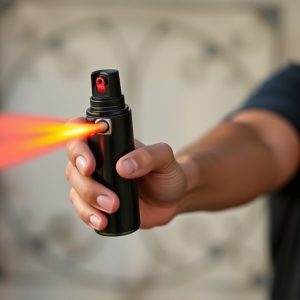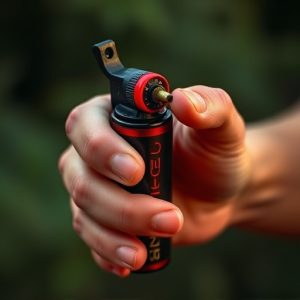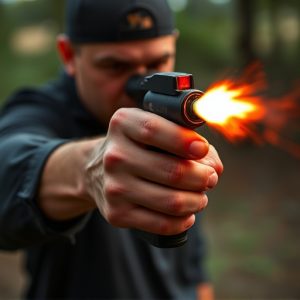Maximizing Effectiveness: Pepper Spray Deployment Techniques and Legal Insights
Pepper spray, a self-defense tool using capsaicin from chili peppers, is most effective within a 2-3…….
Pepper spray, a self-defense tool using capsaicin from chili peppers, is most effective within a 2-3 meter range. Understanding this deployment distance and local regulations is vital for optimal use. Regular training in diverse scenarios improves accuracy, timing, and control, enhancing safety. Despite common perception, its effectiveness is limited by wind, clothing, and body chemistry; proper training and legal knowledge are crucial for responsible use.
“Uncover the power of pepper spray as a crucial self-defense mechanism in today’s world. This comprehensive guide explores the science behind its effectiveness, delving into the chemical composition that disrupts vision and breathing. We dissect deployment techniques to optimize range and accuracy, ensuring users can defend themselves with confidence.
From legal perspectives to busting common myths, this article navigates regulations and clarifies misconceptions surrounding pepper spray’s use. Discover the key to effective deployment distances and range, empowering individuals to make informed choices for personal safety.”
- Understanding Pepper Spray: The Chemical Composition and Its Effectiveness
- Deployment Techniques: How to Maximize the Range and Accuracy of Pepper Spray
- Legal Considerations: Regulations and Use Cases for Self-Defense
- Common Misconceptions About Pepper Spray: Debunking Urban Legends
Understanding Pepper Spray: The Chemical Composition and Its Effectiveness
Pepper spray, a powerful deterrent and self-defense mechanism, has been widely adopted for its effectiveness in neutralizing potential threats. At its core, pepper spray is a chemical compound designed to cause temporary blindness, coughing, and difficulty breathing when sprayed into the eyes and respiratory system of an aggressor. The active ingredient, capsaicin, is derived from chili peppers and is known for its irritant properties. This compound is usually suspended in a liquid solution, allowing for easy deployment through cans or devices.
The effectiveness of pepper spray lies not only in its chemical composition but also in the distance it can be deployed safely. The average effective range of pepper spray is between 2 to 3 meters (6.5 to 10 feet), making it a close-quarters defense mechanism. This range ensures that users can maintain a certain distance from potential attackers while still causing enough discomfort to deter or disable them. Understanding the deployment distance is crucial for individuals looking to incorporate pepper spray into their personal safety strategies, as it provides valuable insight into its practical applications and limitations.
Deployment Techniques: How to Maximize the Range and Accuracy of Pepper Spray
Maximizing the effective range and accuracy of pepper spray deployment is crucial for self-defense and law enforcement applications. Training and practice are key to mastering proper technique. Holding the spray can at the appropriate angle and distance allows for a more focused, powerful stream, increasing its impact on the target. Effective deployment also involves understanding wind conditions, aiming for the eyes and face, and using short, controlled bursts to maximize the stinging effect while minimizing exposure to the irritant.
Practicing in various scenarios, including different distances and obstacles, helps individuals develop a keen sense of timing and control. Regular practice sessions can significantly improve accuracy, ensuring that pepper spray is delivered with precision, even under stressful conditions. Ultimately, mastering these deployment techniques enhances safety and effectiveness, making pepper spray a valuable tool for deterring potential threats.
Legal Considerations: Regulations and Use Cases for Self-Defense
In many jurisdictions, the legal considerations surrounding pepper spray as a self-defense mechanism are stringent. The use of pepper spray is regulated to ensure it’s employed responsibly and effectively. Laws dictate the types of situations where pepper spray can be used, who can possess it, and the associated penalties for misuse or illegal deployment. For instance, in some regions, individuals may only use pepper spray for self-defense if they are facing an imminent threat, making it a powerful yet tactical tool when deployed within its effective range—typically between 2 to 3 meters (6 to 10 feet).
Regulations also outline the types of entities that can legally acquire and employ pepper spray. In most cases, law enforcement agencies and individuals with valid self-defense permits are authorized users. The specific use cases vary by region, but common scenarios include personal protection during high-risk activities, such as outdoor pursuits or travel in areas known for criminal activity. Understanding local laws is crucial to ensure that pepper spray is used appropriately and within the permitted deployment distance range, making it an effective deterrent against potential assailants without crossing legal boundaries.
Common Misconceptions About Pepper Spray: Debunking Urban Legends
Many urban legends surround pepper spray, leading to common misconceptions about its effectiveness and proper use. One such myth is that pepper spray can always incapacitate an attacker from a long distance, often portrayed in movies as a simple solution for self-defense. The reality is that the effective pepper spray deployment distance range is significantly shorter than commonly believed. These sprays are designed to temporarily blind and disrupt an assailant’s senses, but they require close proximity to be truly effective.
Another misconception is that pepper spray is always a guaranteed defense mechanism. In truth, factors like wind direction, the attacker’s clothing, and even their body chemistry can affect how well it works. It’s crucial to remember that while pepper spray can provide an important advantage in dangerous situations, it is not foolproof. Proper training in its use, understanding its limitations, and being aware of legal implications are essential aspects of employing pepper spray as a deterrent.
Pepper spray, when deployed effectively, can be a powerful self-defense tool, offering a safe and legal means of deterring potential threats. By understanding its chemical composition, mastering deployment techniques to maximize range and accuracy, and being aware of legal considerations, individuals can harness the benefits of pepper spray as a reliable personal defense mechanism. With proper knowledge and responsible use, pepper spray can provide peace of mind in various situations, ensuring users are equipped to handle unexpected challenges effectively.


